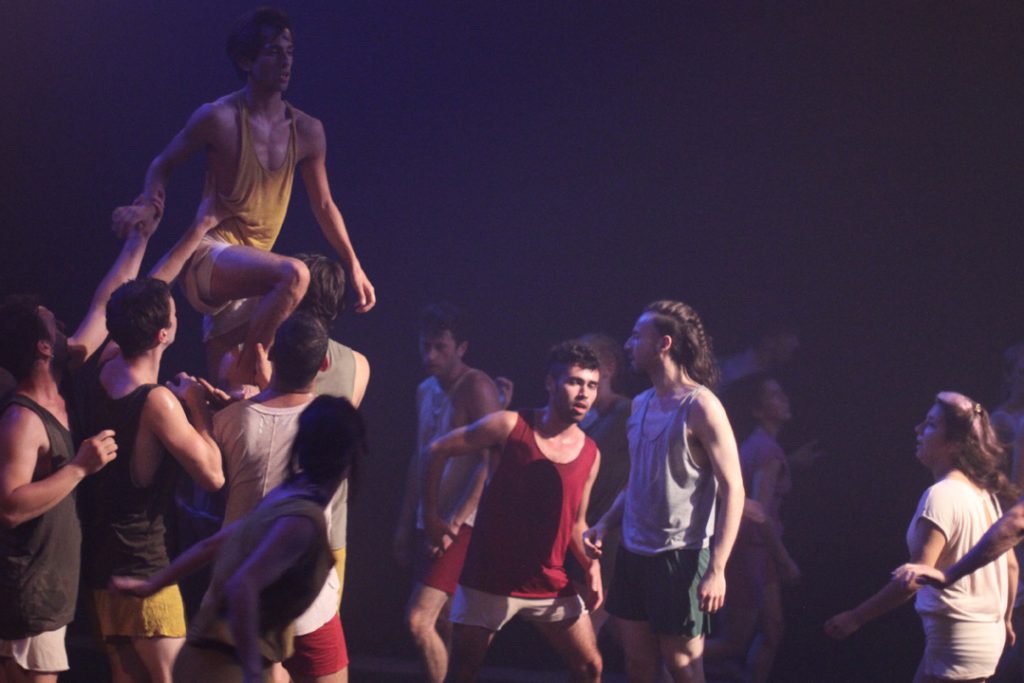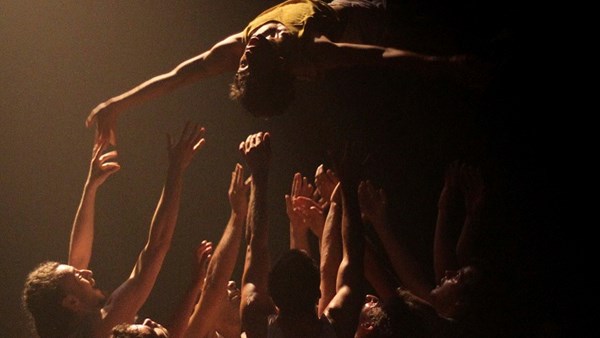Rito de Primavera, begin deze week te zien tijdens het Holland Festival, is een groepschoreografie voor vijftig jonge dansers. Choreograaf José Vidal heeft zich losjes gebaseerd op Sacre du printemps, het stuk van Stravinsky en Nijinsky voor de Ballet Russes uit 1913. Flarden van de muziek van Stravinsky zijn door DJ Jim Hast in 4-kwart beetz omgezet, terwijl Vidal het rituele aspect van het offer, essentieel voor de vele versies die er in de loop van de twintigste eeuw gemaakt zijn (naast de oerversie van Nijinsky, o.a. Massine, Béjart en Bausch), tot een minimum heeft teruggebracht.
Wat overblijft is een overweldigende visuele ervaring van een uit het donker opdoemende gigantische massa dansers. De coördinatie van de groep, die nu eens wild door elkaar danst, dan weer in lange optocht over het podium cirkelt, is indrukwekkend. Het levert een fascinerende, ogenstrelende esthetiek op, maar de groepsdans vormt op geen enkele manier een uitdaging voor de toeschouwer. Je zou het een berg kitsch kunnen noemen, of opium voor het volk. In ieder geval is het een vorm van spektakel, die ik het Holland Festival onwaardig acht.
Schoolreisje
De voorstelling begint als een schoolreisje. Nabij de kassa worden toeschouwers in groepjes voorbereid op wat komen gaat. Vriendelijk wordt hen verzocht om bij binnenkomst van de theaterruimte de schoenen uit te trekken, om vervolgens op blote voeten, hand in hand met medetoeschouwers, een wandeling door het donker te maken. Regelmatig roept er iemand luid om stilte, de voorstelling is namelijk al begonnen. Ook de zenuwachtige manier waarop het publiek, dat zich na de instructies in rijen dient op te stellen, wordt weggemarcheerd naar de voorstellingsruimte twee panden verder, heeft iets ongemakkelijks.
De inwijding van de bezoekers gaat verder in de Zuiveringshal, wanneer zij hand in hand met het koele zand aan hun voeten door het pikkedonker gaan. Het levert één van de weinige ambigue momenten op tijdens Rito de Primavera. Waar gaat dit heen? Welk sprookje worden wij hier binnengeleid? Van welke toeristenboot zijn we afgevallen, om nu de rituelen bij te wonen van welk volk ook al weer?
Naakt!?
Aanvankelijk krijgt de totaal-ervaring, waar zoveel hedendaagse attractieparken naar op zoek zijn, werkelijk gestalte. Een half uur lang staar ik naar een podium in het donker. Ik zie en voel dat daar heel veel mensen zijn, ik denk naakt want soms is er een uitgekiende flits van zacht licht, maar het dominante duister belet mij er grip op te krijgen. Etherisch gezang, gecomponeerd door Andrés Abarzúa – één enkel akkoord klinkt klaterend uit vele kelen – begeleidt een half uur lang de entree van alle andere toeschouwers.
De tribunes staan rondom het speelvlak. Het zijn enkel de rode en witte fietslampjes van de gidsen van de vele groepjes toeschouwers, die je enige oriëntatie geven in de ruimte. Het heeft iets van Kuifje in Takatukaland. Een publiek dat betaalt om bij een wonderbaarlijk, nog nooit vertoond, voorjaarsnymfen-ritueel te zijn.

Logica
De kunstmatigheid van de setting geeft een bepaalde spanning. In het duister kun je je als toeschouwer van alles voorstellen bij wat komen gaat. Maar op zeker moment gaan de fietslampjes uit, een teken dat alle toeschouwers zitten, en trekken de dansers allen een broek aan. Het licht neemt toe en de eerste beetz annex stravinsky verdringen het gezang. Als na de onzekere introïtus het eigenlijke spektakel een aanvang neemt, wordt de logica ervan al te duidelijk. Een perfect georganiseerde groepschoreografie neemt over.
In wat volgt wordt niets aan het toeval overgelaten. En dat is ook geen luxe met zoveel dansers in het halfduister, temeer omdat ook nog eens de helft nieuw is in het werk, want van de afdeling Moderne Theaterdans van de Amsterdamse Hogeschool. De groep maakt pulserende bewegingen, dialogeert met een naaste, rent in groepen, begint opnieuw te zingen, posteert zich en heft zo nu en dan een enkeling in de lucht.
Effect-belust
Maar net zoals het duister went, zo went ook de groep. Het zijn allemaal heel jonge mensen, die redelijk ontspannen samen dansen. De onbevangen houding waarmee de gecompliceerde groepschoreografieën worden uitgevoerd is ontroerend. Er spreekt een naïef soort overgave of geloof uit.
Maar gaandeweg gaan de effecten, van de groepschoreografie, van het licht dat de fotografische vergezichten creëert, de repeterende zang en beetz vervelen. De herhaling van zetten is effect-belust, retorisch, zichzelf bevestigend. Nergens een moment van debacle, van hapering. Niemand die een vraag heeft, niet mee kan, zich vergist of zelfs maar even stil staat. Iedereen in deze groep lijkt te weten waar het heen gaat en zondermeer bereid te gaan.

Macarema
De Macarema dansen op een stravinsky-beat, badend in rood licht. Een nonchalant ingezet expressionistisch midden tussen ballet en moderne dans leidt tot veel armen en benen dramatisch gestrekt en gekromd. Een zekere geilheid wordt gesuggereerd, uitgebeeld zou je vroeger gezegd hebben, maar nergens lijkt iemand echt verstrikt te raken in een omhelzing. Het tempo ligt hoog en de dansers volgen bereidwillig het grote plan. Dit is natuurlijk ook de kern van het voorjaarsoffer-ritueel, dat iedereen zich overgeeft, zonder vragen te stellen of bedenkingen te uiten.
Ergens over de helft, wanneer de beetz al een paar keer zijn opgevoerd tot party-dikte, wenken de dansers het publiek en nodigen hen uit mee te komen doen. Hele rijen toeschouwers begeven zich gretig naar de dansvloer en dansen mee, hun armen in de lucht, hun heupen enigzins zwoegend. Maar het moment is relatief kort. Het is maar een gimmick. Zoals de hele voorstelling een uitwisseling tussen velen suggereert, maar in feite een goed georganiseerde exercitie is, vol clichés.
Gedisciplineerd
Gedisciplineerd laten de festivalbezoekers zich terugvallen in hun rol als toeschouwer. Zo snel als ze uit hun rol stapten, zo snel zitten ze weer naast mij, opgetogen – het was wat benauwd in het midden van de dansvloer, vertelt mijn buurvrouw. Om half tien zitten we, na een trance party van hooguit 10 minuten en zonder pillen, stil te kijken hoe het licht blauw-groen wordt. Kennelijk is het nu tijd voor de ochtendstond, the morning after. Het gezang neemt het weer over, net als in het begin. De groep formeert zich met kleine gestes in een grote cirkel op de rand van het speelvlak.
De choreograaf Laurent Chetouane heeft een aantal jaren geleden een Sacre gemaakt zonder offer. Ook Vidal laat dat moment gaan. Maar in tegenstelling tot Chetouane, bevraagt Vidal dat moment van transformatie, van offering, van iemand laten lijden namens velen -zo essentieel voor de traditie van het herinterpreteren van dit hoegenaamd paganistische ritueel- niet. Hij stelt er een fast-forward trance feestje voor in de plaats.
Risiscoloos
Alle extatische en apocalyptische beelden ten spijt – mij kwamen fresco’s uit Perugia en Assisi, beeldengroepen uit Pisa en Lucca voor de geest, maar ook Franse kathedralen en Pieter Breughel (de oudere) – weet Vidal nergens ook maar een moment iets meer te zeggen, met zijn zorgvuldig geordende-ongeordende massa, dan dat het een feest is om samen te zijn. In tijden van aanslagen, van crisis op crisis, van blame-games en de publieke offering online of op straat, overal in de wereld, voelt het als een totaal misplaatste vanzelfsprekendheid deze Rito zo voor te spiegelen. Er wordt geen risico genomen, geen vraag gesteld, geen verlies geleden.
Ik kan mij voorstellen dat een zeker escapisme gehuldigd dient te worden, en dat zowel in Londen als in Santiago, de steden waar Vidal actief is, de feesten druk bezocht worden. Maar het blijft de vraag wat een mens, wanneer hij of zij dan eindelijk in het theater is aangekomen, moet met deze disco.
Gezien op dinsdag 6 juni tijdens het Holland Festival
